Key Insights
- TRX’s market capitalization increased to $9.4 billion, up 87% YoY from $5 billion. TRX remains one of the top cryptoassets by market capitalization.
- Q4 revenue in USD was up 14% QoQ from $105 million to $119 million. As for all of 2023, the only networks that had higher revenues than TRON were Ethereum and Bitcoin.
- Total stake increased 4% YoY to 46.1 billion TRX. Stake 2.0 utilization continues to grow, with 30% of the staked supply choosing this option.
- USDT on TRON built off its strong 2023 and grew 11% in Q4. At quarter end, 50% of all issued USDT was on TRON.
- stUSDT on TRON grew to the second largest RWA protocol in Q4. Over $2.2 billion USDT has been deposited to the protocol.
Primer on TRON
TRON (TRX) is a public open-sourced blockchain network using a Delegated-Proof-of-Stake (DPoS) mechanism. It utilizes an election mechanism that determines who maintains the network. All TRX stakers vote onchain on which candidates they want to become Super Representatives. In each epoch, the top 27 most voted-for candidates become Super Representatives within the active set and take turns producing blocks. An election occurs every six hours.
The TRON Virtual Machine (TVM) powers applications on the network and uses “Energy” and “Bandwidth” instead of gas, like its Ethereum Virtual Machine (EVM) counterpart. Bandwidth is gas spent on transactions whereas energy is gas spent on smart contract calls. Energy and Bandwidth can be acquired by staking TRX or by burning TRX to pay for the Energy/Bandwidth required to execute a smart contract call or transaction. The TVM is EVM-compatible and offers developers affordable and fast smart contract execution.
Website / X (Twitter) / Discord
Key Metrics
Financial Overview
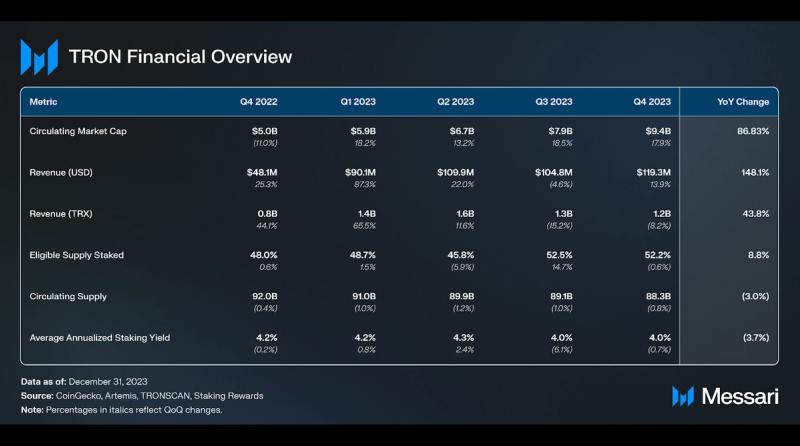
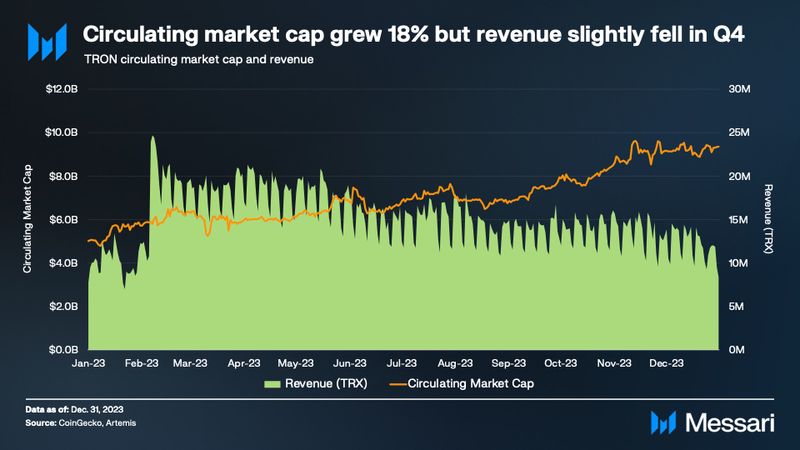
The circulating market cap of TRX continued its grind up in Q4’23, rising 18% to $9.4 billion. Despite the growth, TRX underperformed the broader crypto market, which grew by 54% in Q4. Because of this underperformance, TRX’s rank amongst all cryptocurrencies dropped two spots to #12. All in all, Q4 capped off a strong year for TRX’s price performance as it finished the year up 87% from $5 billion to $9.4 billion. The performance is worth noting as price was likely additionally suppressed due to concerns from the Securities and Exchange Commission (SEC) alleging that TRX was a security in Q1.
TRON utilizes a resource model to execute transactions onchain. To summarize, the resource model is based on distributing Bandwidth and Energy to stakers. As long as stakers have acquired enough resources, they can use those resources to transfer tokens and execute smart contracts for free. Users must cover transaction fees with TRX if they utilize more computing power than their resources. Furthermore, all TRX used to pay transaction fees is burned. As such, revenues for TRON are derived from TRX token burns from transaction fees.
Q4’23 was TRON’s best quarter yet in terms of USD revenue, increasing by 14% to $119 million. November in particular saw 407 million TRX ($41.6 million) burned. In USD terms, November set an all-time high (ATH) for monthly revenue, beating out May 2023 ($40 million). Furthermore, Q4 revenue was up YoY in both USD (+148%) and TRX (+44%).
Over the past year, TRON brought in $424 million in fees, ranking #3 across all networks in fee generation. The only networks with more fees in 2023 were Ethereum ($2.5 billion) and Bitcoin ($797.9 million).
Ultimately, the resource model parameter changes likely improved TRX’s value, supporting the price of TRX throughout 2023.
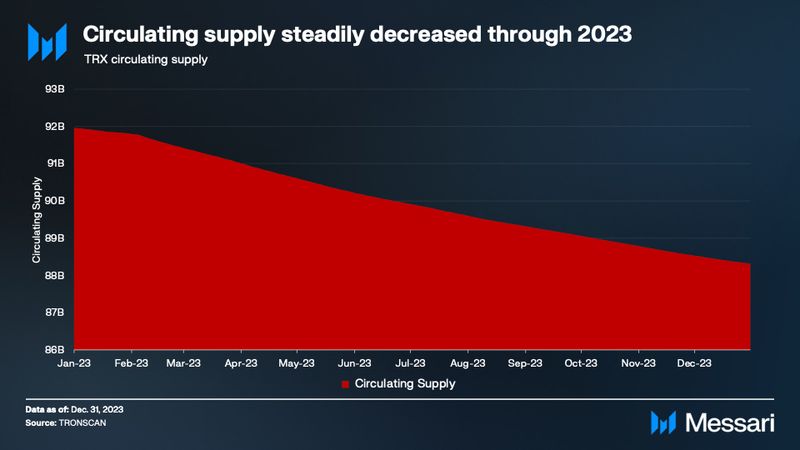
The circulating supply of TRX is affected by two parameters. As previously mentioned, all transaction fees paid in TRX are burned, which leads to deflationary pressure on the supply of TRX. Additionally, new TRX enters the circulating token supply as rewards for stakers and block producers. These rewards work out to roughly 5.06 million TRX minted per day. Therefore, the circulating supply of TRX will decrease over time, as long as more than 5.06 million TRX is burned daily.
Over Q4’23, the circulating supply of TRX decreased from 89 billion to 88 billion QoQ, making it one of the few deflationary Layer-1 networks. Over the full year, circulating supply decreased by 3%.
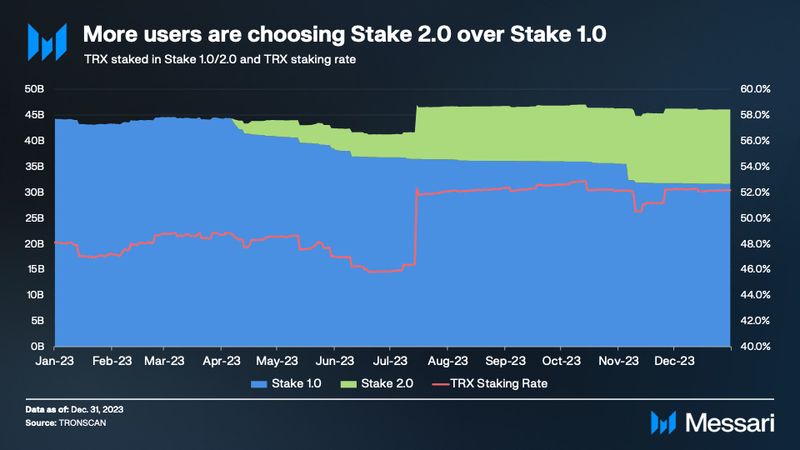
To stake TRX on TRON, users can choose between Stake 1.0 and Stake 2.0. The new staking mechanism, Stake 2.0 (TIP-467), went live in April. It implemented a new layer to separate low-frequency staking operations and high-frequency resource delegating operations. It also introduced resource re-delegating without unstaking and improved resource utilization. Of note, while all newly staked TRX since the upgrade is staked via Stake 2.0, TRX previously staked via Stake 1.0 remains valid.Across both staking options, the staking ratio (the proportion of TRX’s total supply actively being staked) essentially remained the same, decreasing slightly to 52% in Q4. However, more users continued to switch to Stake 2.0 over 1.0 in Q4. Stake 2.0 ended the quarter with 14 billion TRX staked (+33% QoQ), whereas Stake 1.0 finished with 32 billion TRX staked (-12% QoQ).
As previously mentioned, new TRX is minted as rewards for stakers and block producers. TRON incentivizes participants in its staking mechanism through a combination of the following:
- Block Reward – Super Representatives earn 16 TRX for each block produced (subject to change through onchain governance). After producing a block, the Super Representative’s chosen commission ratio is kept, while the remaining TRX is distributed amongst the representative’s associated voters.
- Vote Reward – The 28th to 127th most voted-for Super Representatives become Super Representative Partners for the next epoch. While partners do not participate in block production, they still receive voting rewards, as well as the TRX stakers that voted for said partners. For every block produced, 160 TRX is rewarded to Super Representatives and Super Representative Partners in proportion to their respective TRX stakers’ votes.
The average annualized staking yield from these rewards slightly decreased throughout 2023. In Q1, the staking yield averaged 4.3%, but by Q4, it had dropped to 4.0%. Nonetheless, staking yields for TRX remained an attractive option for TRX holders throughout the year, as evidenced by the 9% increase in eligible supply staked YoY.
Network Overview
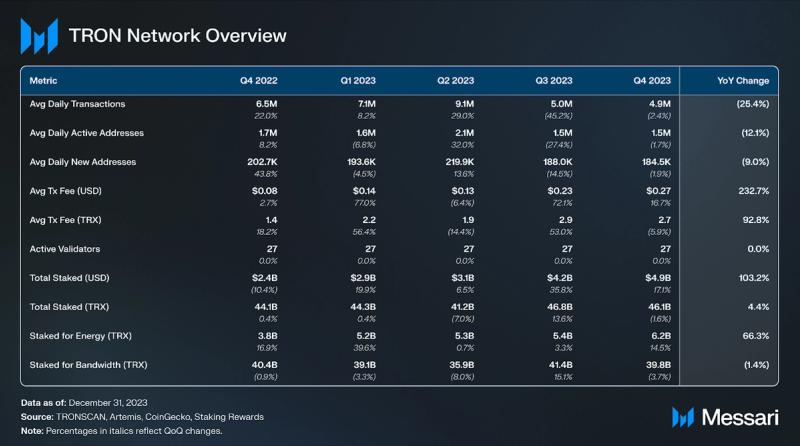
Usage
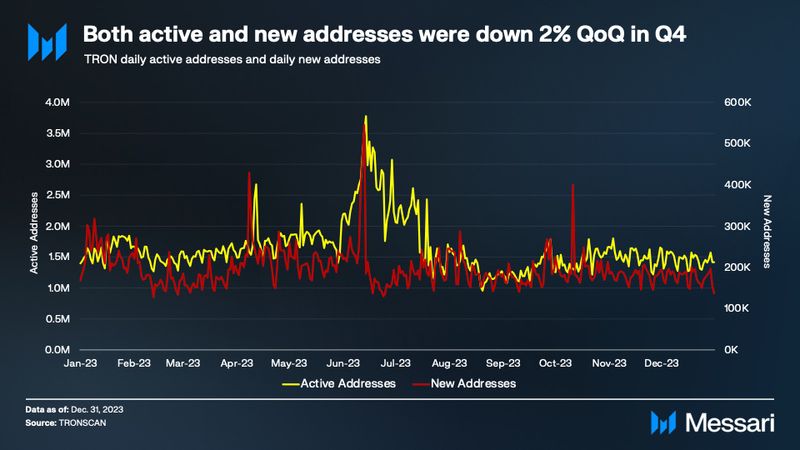
In Q4’23, daily active addresses remained flat, slightly decreasing QoQ by 2% to 1.5 million. Notably, active addresses remain low compared to 2022. There were 1.7 million daily active addresses in Q4’22, down 12% YoY. Daily new addresses were also slightly down Q4, decreasing 2% to 185,000. Daily new addresses are also down YoY as there were 203,000 daily new addresses in Q4’22.
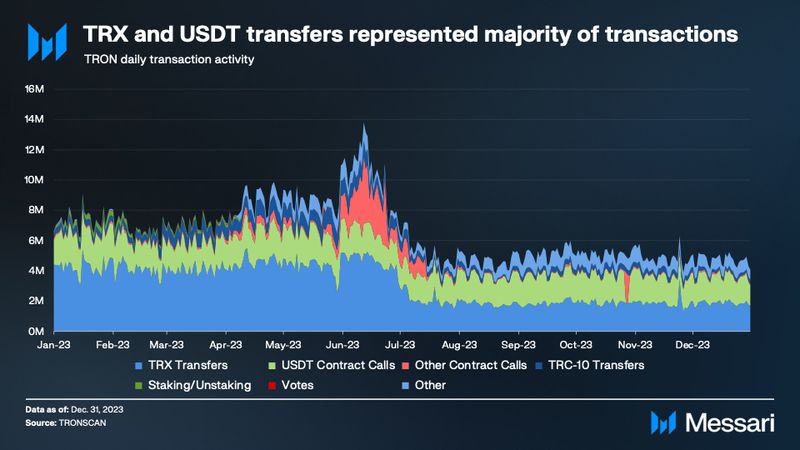
Average daily transactions followed a similar pattern as account activity and decreased by 2% to 4.9 million over Q4. This decrease was driven entirely by “staking/unstaking” transactions (down 14% QoQ) and “other” transactions (down 10% QoQ). “Other” transactions include account creation, SR account creation, account permissions update, proposal initiation, and other non-smart contract interactions on the network.
TRX transfers and USDT contract calls continue to represent the bulk of transactions on TRON, combining for over 75% of transactions in Q4. The transaction category with the most growth in Q4 was “other” contract calls (all contract calls not including USDT contract calls), which grew by 103% QoQ from 112,000 daily transactions to 226,000.
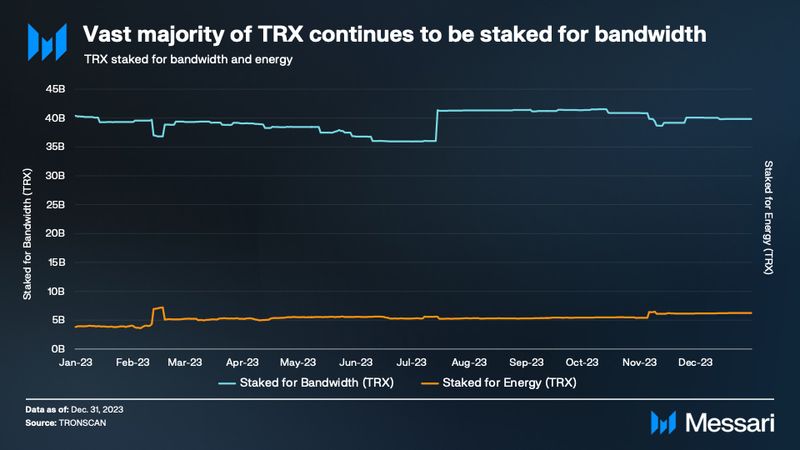
Bandwidth is the gas spent on transactions while energy is the gas spent on contract calls. Users can stake TRX to acquire either resource accordingly:
- The amount of bandwidth obtained from an account’s stake = (the amount of TRX staked for obtaining bandwidth / the total amount of TRX staked for obtaining bandwidth in the whole network * 43,200,000,000)
- The amount of energy obtained from an account’s stake = (the amount of TRX staked for obtaining energy / the total amount of TRX staked for obtaining energy in the whole network * 90,000,000,000)
The vast majority of TRX in Q4 was staked for bandwidth. However, the amount staked was down 4% QoQ from 41.38 billion to 39.83 billion. As for energy, staking increased 15% QoQ from 5.45 billion to 6.24 billion. Furthermore, bandwidth staking decreased by 1% YoY while energy staking increased by 66% YoY.
The amount staked for each resource moved in tandem with consumption. Daily bandwidth consumption was down 37% YoY from 1.9 billion to 1.2 billion while daily energy consumption was up 61% YoY from 36 billion to 58 billion.
Security and Decentralization
TRON uses a Delegated Proof-of-Stake (DPoS) election mechanism and the Practical Byzantine Fault Tolerance (PBFT) consensus algorithm to secure the network. A DPoS election occurs every six hours, in which 27 Super Representatives (SRs) take turns producing blocks. Those who wish to run a node on TRON can pay 9,999 TRX to become an SR candidate.
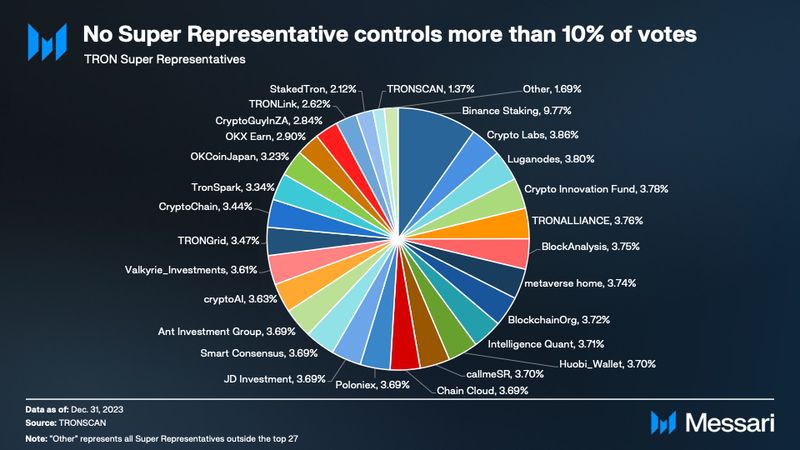
There may be concerns about having only 27 SRs participating in securing the network. But, at the end of Q4, over 400 SR candidates (up from ~380 in Q4’22) received votes. The growing number of SR candidates should challenge the voting population to distribute votes to new candidates. Additionally, no singular entity received more than 10% of all votes.
Although a democratic voting system for block production and a growing set of SR candidates may be beneficial, neither one fully does away with centralization risks. Metrics such as the geographic diversity of nodes may also factor into a network’s level of centralization.
Many Layer-1 networks struggle with the geographical concentration of their nodes. Too many nodes in the same location could jeopardize the health of a network due to geopolitical risks, regulations, and acts of nature, among other reasons.
As of December 31, TRON nodes were distributed across more than 75 geographic locations around the globe, with the highest concentration in China (~21%).
In order to take over the network through a two-thirds attack, a malicious actor would need to control 18 of the 27 SRs. To do this, the malicious actor would need to essentially control two thirds of the total stake. At the end of the quarter, this threshold was 31 billion TRX ($3 billion)
Ecosystem Overview
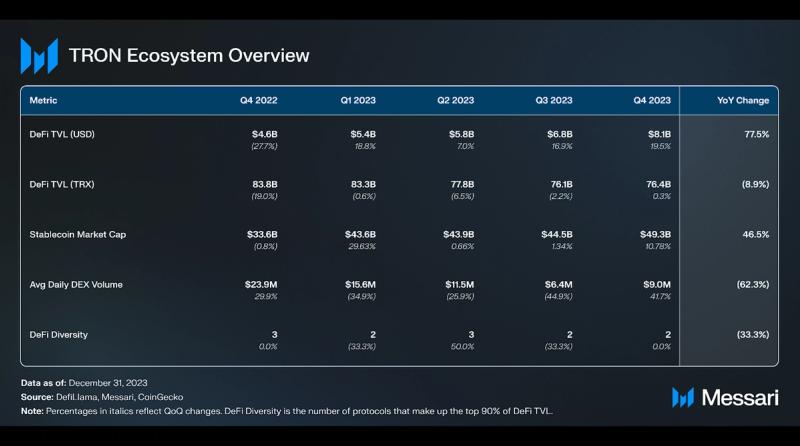
DeFi
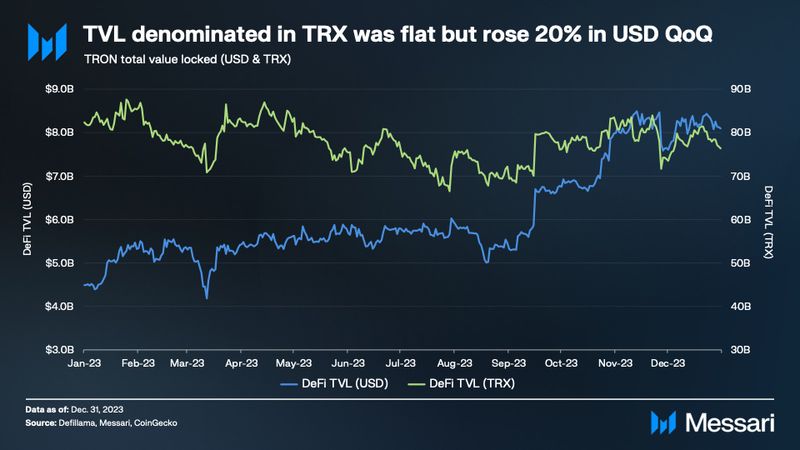
TVL on TRON saw signs of strength in Q4’23, rising by 20% QoQ from $6.6 billion to $8.1 billion. However, TVL denominated in TRX was flat, remaining at 76 billion TRX. By the end of Q4, TRON remained the second-highest network by TVL and more than double the TVL of the third-highest network, BNB Chain ($3.46 billion).

TRON’s most prominent protocols by TVL, JustLend, JustStables, and SUN continue to represent over 99% of TVL on TRON. Of the three though, only JustLend increased its TVL dominance (17% QoQ). JustLend increased its TVL in USD by 40%, QoQ while JustStables and SUN decreased by 21% and 34% QoQ, respectively.
The growth in TVL on JustLend was partly driven by new deposits, namely stablecoins. There were significant inflows of wstUSDT deposits in October ($492 million) and USDT deposits in December ($53 million). Additionally, JustLend TVL benefited from the price appreciation of deposited volatile cryptoassets, such as BTC and TRX. However, the appetite for borrowing on TRON remains quite small. Although borrows on JustLend increased by 26% QoQ from $86 million to $107 million, they still represent less than 2% of the protocol’s TVL.

DEX volumes on TRON decreased for three consecutive quarters prior to Q4, following broader trends within the market, but bounced back this quarter. The average daily DEX volume on TRON increased by 42% QoQ to $9 million. DEX volumes still struggled YoY though, decreasing 62% from $24 million.
Furthermore, essentially all DEX volumes on TRON come from SUN. In June 2023, SUN introduced concentrated liquidity (CL) to its SunSwap V2 AMM. As a result of this feature, SunSwap V2 AMM volumes surpassed SunSwap V1 AMM’s volume in November for the first time since CL was introduced ($199 million versus $149 million).
Stablecoins

Stablecoins continue to be TRON’s killer product as its market cap increased 11% QoQ from $44.5 billion to $49.3 billion. USDT represents a staggering 94% of all stablecoins on TRON. As such, TRON has greatly benefited from USDT’s growth in 2023. At the beginning of the year, there was $31.7 billion USDT on TRON. By the end of the year, this amount increased by $14 billion to $46.3 billion (46% YoY). Additionally, approximately 50% of all USDT in circulation is on TRON.
Other stablecoins that increased QoQ on TRON include USDD (up 22% QoQ to $706 million) and USDJ (up 6% QoQ to $71.2 million). TUSD (down 31% QoQ to $1.9 billion), USDC (down 30% QoQ to $283 million), and HUSD (down 4% to $203,000) all lost market share in Q4. Zooming out, the biggest gainer in percentage terms on TRON in 2023 was TUSD, growing 646% YoY from $251 million. The biggest loser in percentage terms on TRON in 2023 was USDC, falling 75% YoY from $1.1 billion.
RWAs
TRON announced the launch of its first real-world asset (RWA) platform, stUSDT, in Q3. stUSDT is a receipt token that users will receive upon staking USDT. USDT staked in the stUSDT-RWA contract will be allocated to real-world assets. Users will then receive continuous yield from those assets through a rebase mechanism.
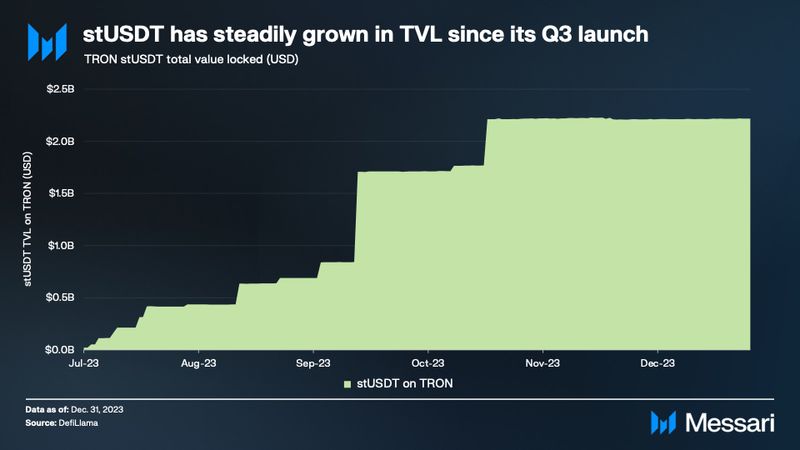
stUSDT has seen consistent growth. In its first year of existence, it reached a TVL of $2.2 billion on TRON alone. Furthermore, it is one of two RWA protocols that has over $2 billion in TVL, with the other being Maker RWA. Lastly, as of December 31, 2023, over $30 million in yield had been rewarded from stUSDT on TRON, with a median APY of 4.74%.
Development
Although Q4 was a quiet quarter for development on TRON, there were some notable headlines. On October 4, 2023, TRON announced that they had joined Google Cloud’s BigQuery service. BigQuery is a serverless data warehouse that allows users and developers to analyze TRON data in real time without utilizing an individual node.
On October 25, 2023, TRON mainnet was upgraded to GreatVoyage-v4.7.3(Chilon). Chilon is a non-mandatory upgrade that improves the development experience on TRON by (i) fastening the speed associated with node startup and initialization, and (ii) optimizing the performance of network infrastructure. A full list of changes associated with the update can be found here.
Finally, on December 6, 2023, Justin Sun announced four key initiatives for TRON, one of which is a $100 million developer fund. Although details have not been formalized, its funding could be related to the $1 billion TRON DAO Ecosystem Fund.
Ecosystem Growth
TRON DAO continues implementing strategies to grow the ecosystem beyond stablecoins and JustLend, with initiatives such as the TRON DAO Grants Program, a $100 million AI development fund, and the TRON Grand Hackathon seasons.
During Q4, the Grand Hackathon Season 5 attracted over 3,500 participants. It also awarded 500,000 USDD in prizes to winning teams across five different tracks, including Artistry, AI, Web3, DeFi, and Builder.
Judges selected the following first-place qualifiers for Season 5:
- LoopNFT – Artistry Track
- ScannerBot – AI Track
- Bounce – Web3 Track
- DebitLLama – DeFi Track
- Tronsave – Builder Track
Each of the aforementioned teams received a first-place prize of 25,000 USDD. Furthermore, the community selected the following first-place qualifiers for Season 5:
- AsTRONauts – Artistry Track
- TronDevGPT – AI Track
- JustMoney Invoice – Web3 Track
- Wish Me Luck – DeFi Track
- TronHub Microsites – Builder Track
Each of the aforementioned teams received a community-pick prize of $7,000. Some teams even qualified for a prize across all five tracks.
Outside of the Hackathon, TRON announced a new partnership with blockchain-based AI project ChainGPT. ChainGPT will be integrating with TRON to provide users with a toolkit that allows for the easy deployment of smart contracts and NFTs on the TRON network. Additionally, ChainGPT’s AI model was fed TRON data, enabling its chatbot to interact with TRON users. Furthermore, several projects on TRON will also be integrating with ChainGPT for their product, including DexCheck, GT Protocol, and AITECH.
Lastly, on December 6, 2023, Justin Sun announced four key initiatives for TRON:
- Enhancing inscription support on TRON
- Integrating TRON with BRC-20
- Launching a $100 million developer fund
- Reducing energy costs on TRON to attract more users and developers.
As a part of these key initiatives, TRON DAO is considering adding a new track for Season 6 of the Grand Hackathon, “Inscription Section.” Although no formal plans have been announced yet, TRON DAO will likely aim to advance the key initiatives laid out by Justin Sun.
Closing Summary
Q4 wrapped up an impressive year on TRON, as it cemented itself as one of the top smart contract platforms in the space. Revenues in USD hit new highs in Q4’23, coming in at $119 million. Outside of Ethereum and Bitcoin, no other network made more in fees than TRON. Because of the high revenues, TRX was also able to claim its place as one of the few deflationary tokens, with its supply decreasing by 3% in 2023.
TRON’s killer product, and one of crypto’s killer products, continues to be the affordable and fast transfers of USDT. As of writing, $49.3 billion USDT in total is issued on TRON, representing 50% of all USDT in existence. Additionally, the introduction of RWA protocols in the second half of 2023, like stUSDT, represents another opportunity for TRON to benefit from its massive share of the USDT supply.
TRON looks to grow in 2024 with several key initiatives outlined by Justin Sun. The main focus is to attract more crypto developers, through both direct incentivization ($100 million developer fund) and an improved developer experience.
















